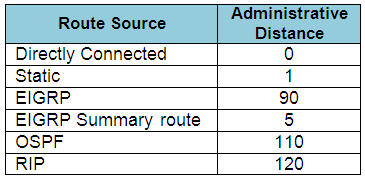OSPF Questions
Note: If you are not sure about OSPF, please read our OSPF Tutorial.
|
Quick OSPF review – OSPF is a link-state routing protocol, which runs Dijkstra algorithm to calculate the shortest path. + Area ID – Two options for OSPF authentication: – Hello packets of OSPF are multicast to 224.0.0.5 OSPF uses the following criteria to select the router ID: The formula to calculate OSPF cost is: Cost = 108 / Bandwidth |
Question 1
Question 2
Question 3
Explanation
The Broadcast network type is the default for an OSPF enabled ethernet interface (while Point-to-Point is the default OSPF network type for Serial interface with HDLC and PPP encapsulation).
Reference: https://www.oreilly.com/library/view/cisco-ios-cookbook/0596527225/ch08s15.html
Question 4
Question 5
Question 6
Explanation
Router2 does not have an entry for the subnet 10.10.13.128/25. It only has an entry for 10.10.13.0/25, which ranges from 10.10.13.0 to 10.10.13.127.
Question 7
Explanation
The default OSPF network type for HDLC and PPP on Serial link is point-to-point (while the default OSPF network type for Ethernet link is Broadcast).
Question 8
Explanation
OSPF uses the following criteria to select the router ID:
1. Manual configuration of the router ID (via the “router-id x.x.x.x” command under OSPF router configuration mode).
2. Highest IP address on a loopback interface.
3. Highest IP address on a non-loopback and active (no shutdown) interface.
Question 9
Explanation
From the output we can see there are Designated Router & Backup Designated Router for this OSPF domain so this is a broadcast network (point-to-point and point-to-multipoint networks do not elect DR & BDR) -> Answer B is not correct.
By default, the timers on a broadcast network (Ethernet, point-to-point and point-to-multipoint) are 10 seconds hello and 40 seconds dead (therefore answer C is correct). The timers on a non-broadcast network are 30 seconds hello 120 seconds dead.
From the line “Neighbor Count is 3”, we learn there are four OSPF routers in this OSPF domain -> Answer D is not correct.
Question 10
Explanation
With the same route (prefix), the router will choose the routing protocol with lowest Administrative Distance (AD) to install into the routing table. The AD of Internal EIGRP (90) is lowest so it would be chosen. The table below lists the ADs of popular routing protocols.

Note: The AD of IS-IS is 115. The “EIGRP” in the table above is “Internal EIGRP”. The AD of “External EIGRP” is 170. An EIGRP external route is a route that was redistributed into EIGRP.
Question 11
Explanation
The default-information originate command advertises a default route into a normal area, provided the advertising router already has a default route. But in the routing table of R1 we don’t see such a default route. Therefore we have to configure one.
We cannot only add the “always” keyword to the command “default-information originate” on R1 because R2 still does not know how to forward traffic received from R1.
Question 12
Explanation
From the output we can deduce interface Gi0/0 on R1 is the interface connecting to Router2 so interface Gi0/1 is the interface connecting to the new MPLS AS 1000.
The AD of eBGP (20) is smaller than that of OSPF (110) so the route to 10.10.13.0/25 will be updated as being learned from the new BGP path.
Question 13
Explanation
The destination of 10.10.13.165 matches the entry “O 10.10.13.160/29 [110/2]…” because of the longest prefix length rule so the packet will be forwarded to 10.10.10.5, which is Router3.



Hi,
can someone help, i’m working on Reference Bandwidth and i’m having trouble with a command.
(R1#show ip ospf | include reference)
The bar key doesn’t seem to be working am I doing something wrong, using shift |
Is there a TRICK!!!!! Does packet-T support this?
May i have explanation on question 4 please?
Thanks heaps
@anishakya: We need to reload the OSPF to reflect the OSPF router ID change and this is the least disruptive way (than reloading the device).
help with question 12
Question 13: i understand it matches on the longest prefix which is
10.10.13.160/29 [110/2] via 10.10.10.5,00:00:12, GigabitEthernet0/1
but router 3 is 10.10.10.4/30, is that assuming its showing you in ingress port for R1 so .5 will be the ingress port for R3 ?
The ip address of the network is 10.10.10.4/30, ip address of the router is .5
where can i see all the questions? answers are visible but no questiond. thanks
Hi Alfred,
do you have the newest dump, please share with jhthello at hotmail dot com?
thanks,
Question 13
The solution has nothing to do with the longest prefix rule.
O 10.10.13.160/29 [110/2] via 10.10.10.5,00:00:12, GigabitEthernet0/1
This is the only route to that network that exists in the routing table other than using the default route. Correct me if I’m wrong here, but it wouldn’t matter what the prefix is for that particular route so long as it’s the only one in the routing table to that network.
hi , there are not any questions.